Since the COVID-19 crisis, we’ve rediscovered the value of good remote collaboration software.
But, the remote teams of the 2010s have always relied on these tools to organize their work and communicate across the world. Slack and Flowdock have pioneered this industry, making lives easier for remote teams ever since their inception.
A lot of time has passed since then, with more and more competitors entering the arena almost every year. So, which of these tools is more relevant today?
Let’s explore them together and see how they fare in everything from pricing to file sharing and user reviews!
About Flowdock
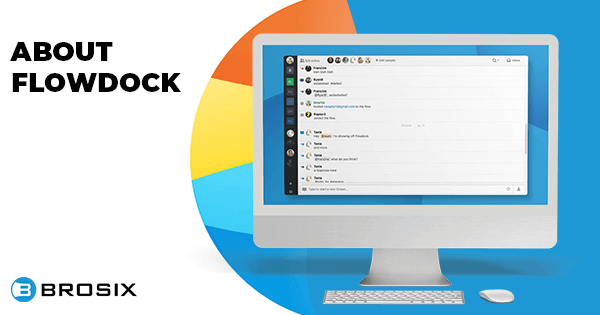
Slack might have become synonymous with remote team collaboration but the Flowdock app actually preceded it by more than three years.
It was released in 2010 and initially targeted developers. Over the years, Flowdock has evolved to expand its offering to companies of all backgrounds but still kept its simple, tech-first interface.
The communication in Flowdock happens through Flows—which you can think of as team rooms, similar to Channels on Slack.
Flowdock is developed in Boulder, Colorado.
About Slack
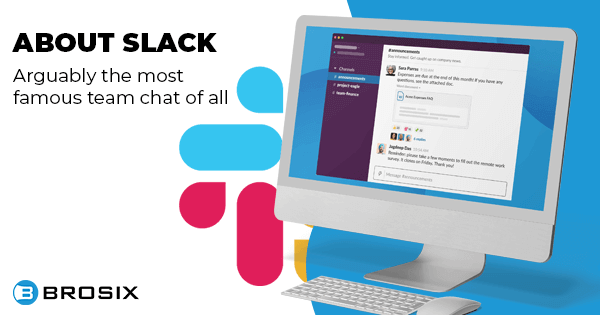
Arguably the most famous team chat of all, Slack started as an internal communications tool for a game development studio. It was released to the public in 2013 and instantly amassed a solid following.
Over the years, Slack introduced more features and grew in usage until it eventually went public in 2019 at a market value of US$19.5 billion.
In January 2021, it was announced that Slack will be acquired by the tech giant Salesforce for approximately $27.7 billion.
Slack is known for its simple and intuitive interface that almost revolutionized the whole industry of internal communication tools. It also offers thousands of integrations with the most popular enterprise services.
How did we compare them?
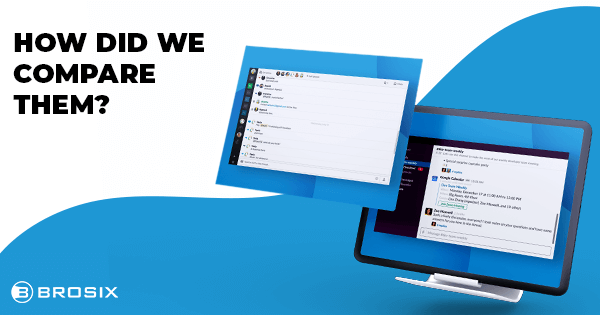
To properly evaluate Flowdock and Slack, we used both tools for two weeks and compared them across these criteria:
- Pricing: efficient team communication is invaluable but its costs can stack up and put a strain on your budget. While that might not be a deciding factor, it’s certainly something you should consider—especially since only one of these tools offers a free plan.
- Setup and interface: first impressions matter, and getting your team up to speed with a new tool can be crucial. In this section, we compared how the two platforms look and feel, as well as how easy they are to set up.
- Communication and file-sharing: creating new chats, mentioning people, replying in threads—all of these are important features that your team might need. Additionally, many group chat tools place significant limitations when it comes to file sharing, which can be a problem if you’re used to doing everything on one platform.
- Safety: enterprise communication should always be secure from outside interference and data leaks. In this section, we’ll be comparing the security protocols behind these two apps.
- Integrations: you’ll likely want your internal communication app to integrate with some of the other software you’re using. Calendars, task tracking tools, file collaboration—all of these should integrate with your communication tool for a seamless experience.
- User reviews: you don’t have to take our word for it: we scanned the Web for user reviews and identified the key issues and advantages of these apps, as reported by their clients.
So, let’s get into it and see how these two tools compare!
Flowdock vs Slack: Pricing
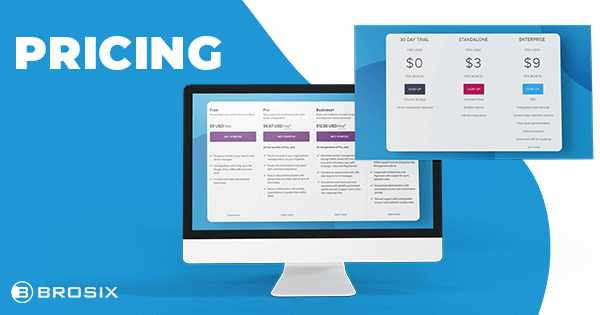
The obvious difference here is the fact that Slack works based on a freemium model: you can use the app for an unlimited time, completely free.
Of course, this comes with some major limitations. Most notably, your chat history will be limited to 10.000 messages, you’ll have access to only 1-to-1 video calls, and the elaborate integrations library will be limited to only 10 integrations.
Still, this is more than enough for small teams that just need a simple team chat tool to communicate easily.
Paid plans include Standard ($6.67), Plus ($12.50), and Enterprise Grid (price on inquiry). All of these prices are on a “per month, per user” payment basis.
Flowdock pricing, on the other hand, only comes in two paid plans: Standalone ($3 per user, per month) and Enterprise ($9 per user, per month). It also provides a free plan but it’s limited to a 30-day trial.
It’s worth noting that, even in the “Standalone” plan, you get unlimited flows, integrations, and chat history.
Flowdock vs Slack: Setup and interface
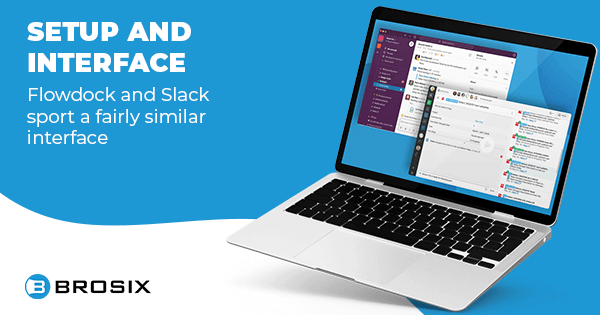
In 2021, you really wouldn’t expect an online tool to have an overly long or complicated sign-up process.
Both Flowdock and Slack deliver in this field but we’re inclined to give a slight edge to Flowdock. If you choose to sign up with Google, it will take you moments to set everything up. Your avatar will even be automatically synced.
On the other hand, Slack excels in onboarding. Everything is very intuitive and the app holds your hand throughout the entire process. You have the (now famous) SlackBot to turn to for all your questions or dilemmas, and you have in-app notifications and prompts that guide you through your first visit.
Flowdock and Slack sport a fairly similar interface. On the left, you have a list of your Channels or Flows. Clicking on one of those opens the conversation in the main tab. The only difference is the tab on the far right—in Flowdock, this shows your team inbox, the whole activity stream from the tools and services related to the selected flow.
Recently, Slack has removed its right sidebar which was reserved for conversation details and pinned items. This is now done through a pop-up window which feels a little strange at the moment so it’ll take some time to get used to if you’re a Slack user.
Overall, Slack has an advantage in the interface department. It looks cleaner and Flowdock’s team inbox doesn’t help the information overload that happens when you turn it on.
Flowdock vs Slack: Communication and file sharing
Creating a channel on Slack is fairly easy: you click on the “Add channels” option in the main sidebar, give the channel a name, a description, and invite members. In a channel, all communication is enjoyed by all the members.
You can mention people and react to messages with a plethora of emojis. This will keep even the team members who tend to doze off at work engaged enough to be part of conversations. And, since any group conversation can easily get sidetracked, Slack has the Threaded conversation feature that allows you to reply directly to any group message and continue having a chat on that topic without alerting all channel members. Slack threads are essentially parallel conversations for which you receive separate notifications in the sidebar.
What Channels are in Slack, Flows are in Flowdock. Team communication in Flows happens through color-coded threads by default so you can always see which particular conversation each message belongs to. You can send a message to the whole group, then drag it up and nest it under the conversation you’re replying to.
For the less tech-savvy teams, this might be a lot of work and planning. Some people just want to agree on what they’re having for lunch while a different conversation is taking place. From what we can tell, this may be easier done on Slack than on Flowdock but it might be more fun on Flowdock, especially if you have a team of developers or project managers.
When it comes to file sharing, Flowdock allows you to upload files up to 200 MB while Slack puts this limit at 1 GB. Slack’s file management also allows for 5GB file storage for a team in the Free plan, 10 GB per user in the Standard plan, and 20 GB per user in the Plus plan.
Flowdock vs Slack: Safety
One thing you can never get enough of when it comes to business communication is data safety. So, how do these two apps fare in this field?
Unfortunately, Slack can’t brag with overly strict or reassuring safety policies. The app is entirely proprietary and all data is stored on their servers. Furthermore, it’s not an encrypted chat app which means that, in theory, Slack could access your conversations if they wanted or were required to do so by the government.
Slack was also famously targeted by a hacking attack in 2015 which prompted the developers to introduce two-factor authentication.
Flowdock goes a little further in the security department and encrypts all data. It also provides some tools for admins to control the members of the network, such as having an overview of login times. You can also check Flowdock’s status at any time and check how the platform is working, including having an overview of all recent incidents.
Overall, these two apps can be considered safe by the most general standards but if safety is your absolute priority, you’ll be better off with Flowdock.
Flowdock vs Slack: Integrations
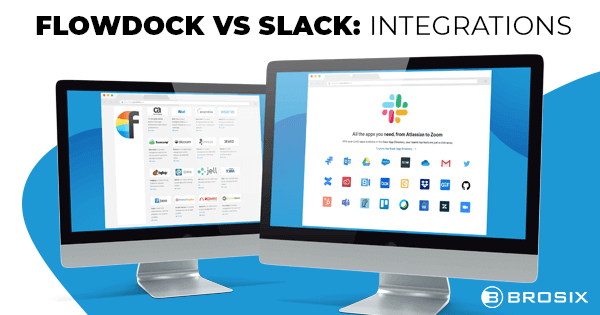
Both Flowdock and Slack offer integrations with the most popular communication and collaboration apps.
Slack is particularly proud of its integration library, boasting over 2.400 integrations with different apps. You can connect your Slack with apps for productivity (Google Drive, Outlook, Google Calendar, etc.), CRM (HubSpot, Salesforce, etc.), communication (Zoom, Skype, Twitter, etc), and other areas of marketing and collaboration.
Flowdock also offers countless integrations with apps that help you execute different actions. However, there is a slight preference for software development tools. Here are some of the most notable integrations Flowdock offers:
- Productivity: Asana, Trello, Basecamp, Jira, Trac, ScrumDesk, etc.
- Version control: GitHub, Gitlab, Beanstalk, Bitbucket, etc.
- Customer support: Salesforce desk, Gemini, SupportBee, Zendesk, etc.
- Wikis: Confluence, Assembla, MediaWiki, etc.
Flowdock vs Slack: User reviews
At the moment of writing, Slack holds a 4.5 rating on G2. Most users praise it for its simplicity and intuitive design. It’s hard to miss notifications, the design is clean, and all the customization options (themes, colors, GIFs) make the chatting experience fun.
Some criticism is directed towards subpar video and voice chat features, especially given the fact that the competition in this field is getting fierce.
Flowdock, on the other hand, is not as well-received on G2 and holds a 3.9 rating at the moment. It’s praised for its integrations with software development tools and the inclusion of Giphy in the communication channels which makes each chat more fun and friendly.
Unlike channels on Slack, flows on Flowdock are not as intuitive and clean—as reported by some users. The interface might take some time to get used to and, even then, the app might look crowded at times. Flowdock is also criticized for a lack of video and voice calling.
Brosix: Safer team communication
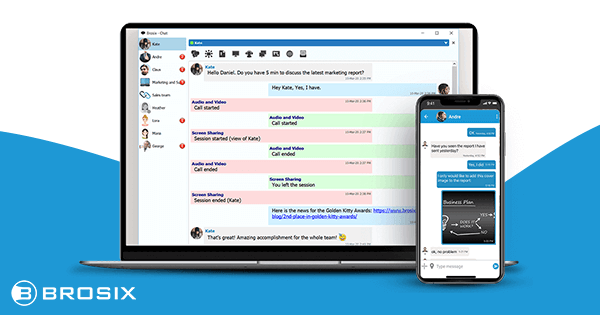
Slack and Flowdock are both quite popular team collaboration platforms but some things can be identified as their weaknesses.
A lack of additional safety features jumps right out, and so does subpar video and voice calling.
With Brosix, you don’t have to worry about any of this.
Brosix guarantees safety—both with industry-level encryption standards and admin control. When you roll out your Private Team Network, you have complete control over which users can access which features, who can communicate with whom, and general user activity, even when they leave your organization. This is done through the Web Control Panel, your own security hub.
Brosix also offers advanced communication features, including voice and video chat. You also have an unlimited chat history, searchable both by date and keyword. And, if you want to bring your presentations to life, you can use the Whiteboard feature that allows you to draw, paint, write text, and interact with the screen in other ways. Perfect for brainstorming and interactive discussions!
The final word
So, what’s our final verdict between Slack and Flowdock?
If you’re looking for a simple team chat solution that takes little time to set up and is highly intuitive, we recommend Slack. It’s free, easy to use, and just looks neat. It’s even better if you have a small team that isn’t very active with communication so the 10.000 message chat limit won’t be as big of a factor.
It’s hard to imagine a scenario where we would choose Flowdock over Slack, other than the obvious advantage it has for development teams. If you have a team of developers, they’ll likely enjoy the integrations with dev tools, along with the overall structure of the app which they might find more intuitive than less tech-savvy individuals.
However, since both of these apps fall short in the safety category, you might find yourself looking for a third option. If that’s the case, we recommend Brosix.
Packed with features, Brosix cuts down on distractions and focuses on what really matters—all while keeping your conversations private and safe.
Request a demo and see for yourself!






